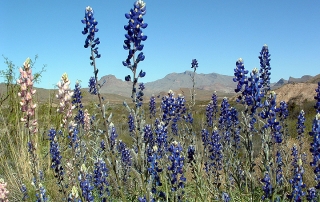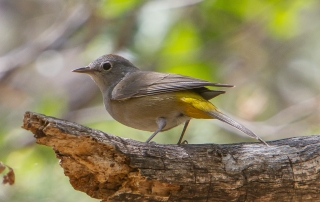List and description of reptiles and amphibians found in Big Bend National Park
Amphibian & Reptile Checklist
Big Bend National Park, in southwestern Texas, was established in 1944 and consists of over 801,163 acres (1,252 square miles) in the Chihuahuan Desert. The herpetofauna (amphibians and reptiles) is diverse and spectacular, but one must look for these animals in the proper place at the right time. Most species of reptiles and amphibians are nocturnal and retreat underground into burrows, rocky crevices, or under stones during the day to escape heat and dryness.
Eleven species of amphibians and 56 species of reptiles are presently recorded for Big Bend National Park. Five additional species are listed as hypothetical. Unfortunately, a few species have been extirpated and no longer occur in the park because of habitat loss and human abuse. Frogs and toads make up the only group of amphibians (11 species). Snakes make up the largest group of reptiles (30 species), followed by lizards (22 species), and turtles (4 species). Subspecies are not listed since they are primarily of academic interest and are often difficult to determine from field observations.
Although some species occur throughout the park, others are restricted to specific habitats and life-zones at different elevations. Five species (four species of rattlesnakes and one species of copperhead) are venomous and are dangerous to humans.
All animals, including reptiles and amphibians, are protected in the park and must not be disturbed, collected, or killed.
CLASS AMPHIBIA
ORDER ANURA – FROGS AND TOADS
___ Couch’s Spadefoot (Scaphiopus couchii)
Common. Lower Green Gulch and Panther Junction to Rio Grande. Burrows into ground or uses burrows of other animals. Most active after rains, nocturnal.
___ Western Spadefoot (Scaphiopus multiplicatus)
Status Unclear. A single park record from Panther Junction. Usually found at higher elevations than is S. couchii. Burrows into ground or uses burrows of other animals. Nocturnal.
___ Spotted Chirping Frog (Syrrhophus guttilatus)
Rare. Chisos Mountains to entrance to Santa Elena Canyon. Under moist rocks, sotols, and agaves. Most active after rains, nocturnal.
___ Canyon Treefrog (Hyla arenicolor)
Uncommon. Chisos Mountains and foothills. Rocky streams and pools, under boulders and stream banks, sometimes in trees. Primarily nocturnal.
___ Green Toad (Bufo debilis)
Uncommon. Flats around Rosillos Mountains and Tornillo Creek floodplain; possibly Terlingua Creek drainage. Low hot desert. Secretive, burrowing. Most active after heavy rains, nocturnal.
___ Red-spotted Toad (Bufo punctatus)
Common. Desert from Rio Grande floodplain to foothills. Burrowing, nocturnal.
___ Texas Toad (Bufo speciosus)
Common. Rio Grande floodplain to Panther Junction and in Rosillos Mountains. Desert areas. Burrowing, nocturnal.
___ Southwestern Woodhouse’s Toad (Bufo woodhouseii)
Rare. Rio Grande floodplain. Burrowing. Most active after heavy rains, nocturnal.
___ Rio Grande Leopard Frog (Rana berlandieri)
Common. Rio Grande floodplain to mountain foothills. Permanent pools, streams, springs, ponds, tinajas, aquatic vegetation. Nocturnal and dirunal.
___ Bullfrog (Rana catesbeiana)
Uncommon. Established in beaver pond at Rio Grande Village; collected outside the park at Lajitas, Texas. Reported calling along Rio Grande.
___ Great Plains Narrow-mouthed Toad (Gastrophryne olivacea)
Uncommon. Rio Grande to Panther Junction in floodplains and desert. Pools, damp crevices, burrows, under rocks, bark and vegetation. Very secretive, burrowing, tiny, toxic skin, nocturnal. Most active after heavy rainfall.
CLASS REPTILIA
ORDER TESTUDINES – TURTLES
___ Yellow Mud Turtle (Kinosternon flavescens)
Uncommon. Rio Grande to Dagger Flats and Rosillos Mountains area. Floodplains and desert, shallow (often temporary) muddy pools and tanks. Has musky odor, mainly nocturnal.
___ Big Bend Slider (Trachemys gaigeae)
Common. Rio Grande floodplain only. Sloughs, ponds, and rivers with muddy bottoms and aquatic vegetation. Diurnal and nocturnal.
___ Desert Box Turtle (Terrapene ornata)
Very rare. Only specimens from Panther Junction (possibly escapes); well established north of park. Prairies. Nonaquatic, diurnal.
___ Spiny Softshell (Trionyx spiniferus)
Uncommon. Rio Grande and rarely adjacent pools. Diurnal and nocturnal. Sometimes accidently caught on baited fish hooks.
___ Mediterranean Gecko (Hemidactylus turcicus)
Very rare. Known only from Rio Grande Village and across the river at Boquillas, Mexico. Human habitations, buildings, screens, often near lights. Has voice, walks on smooth walls and ceilings, nocturnal. Originally introduced from Old World.
___ Green Anole (Anolis carolinensis)
Uncommon. Introduced at Rio Grande Village and established near beaver pond. Thick vegetation. Common in southeastern United States.
___ Texas Banded Gecko (Coleonyx brevis)
Fairly common. From lowlands to foothills (sparingly to Panther Junction and Green Gulch). Rocky deserts, under stones, sotols, and agaves, or in rocky crevices. Nocturnal, has voice.
___ Reticulated Gecko (Coleonyx reticulatus)
Extremely rare. Known only from Presidio and Brewster Counties, Texas. Desert rock outcrops, lowlands. Large, can change pattern intensity, nocturnal, has voice. A threatened species in Texas.
___ Southwestern Earless Lizard (Cophosaurus texanus)
Common. Rio Grande floodplain to foothills (sparingly to Panther Junction). Heat loving, no ear opening, diurnal.
___ Collared Lizard (Crotaphytus collaris)
Uncommon. Lowlands to Chisos Mountains and foothills (Pine Canyon, Panther Junction, Lower Green Gulch). Open deserts with boulders, rocks, and sparse vegetation. Sometimes runs upright, diurnal.
___ Longnose Leopard Lizard (Crotaphytus wislizeni)
Extremely rare. Recorded at Tornillo Flat, base of Rosillos Mountains, between Panther Junction and Rio Grande Village, near Boquillas and San Vicente. Low, hot desert and arid flatlands. Sometimes runs upright, diurnal.
___ Texas Horned Lizard (Phrynosoma cornutum)
Extremely rare. Recent records only from Panther Junction (escapes?) and Nine Point Draw. Well established north of the park. Grasslands, plains, and desert. Diurnal. Listed as a threatened species by the State of Texas.
___ Round-tailed Horned Lizard (Phrynosoma modestum)
Fairly common. Rio Grande to foothills. Desert flats with sparse vegetation, often near ant mounds. Diurnal. Generally similar in color to surrounding rocks or ground cover.
___ Desert Spiny Lizard (Sceloporus magister)
Fairly common. Rio Grande floodplain sparingly to Chisos Mountains foothills (about 4000 ft.); very rare at Panther Junction. Lowlands, desert washes and arroyos with ample vegetative cover, mesquite thickets, prickly pear. Uses animal burrows, climbs trees, very wary, diurnal.
___ Canyon Lizard (Sceloporus merriami)
Common. Rio Grande floodplain well into Chisos Mountains to at least 5500 feet. Canyon walls, cliffs, boulders, rocky arroyos, and rarely adobe buildings. Rock-loving, unwary, diurnal.
___ Crevice Spiny Lizard (Sceloporus poinsettii)
Common. Rocky highlands of Chisos Mountains and foothills; a few records from the river canyons. Rocky faces and boulders having crevices, sometimes buildings. Wary, wedges itself in crevices, diurnal.
___ Eastern Fence Lizard (Sceloporus undulatus)
Fairly common. Chisos Mountains and foothills down to Rio Grande. Trees, shrubs, yuccas, and other upright vegetation; sometimes logs, boulders, buildings, or signs. Readily climbs, diurnal.
___ Side-blotched Lizard (Uta stansburiana)
Common. Rio Grande to foothills, at least to Grapevine Hills and K-Bar. Lowland desert flats, sandy areas, hardpan, fine gravel. Sometimes active in winter, burrowing, diurnal.
___ Tree Lizard (Urosaurus ornatus)
Fairly common. Chisos Mountains and foothills. Rock faces, boulders, trees, boulder beds such as the Grapevine Hills. Climbs,diurnal.
___ Short-lined Skink (Eumeces tetragrammus)
Uncommon. Parkwide, except for possible the highest parts of the Chisos Mountains. Under rocks, agaves, sotols, prickly pears, boards, and logs near springs, seeps, or pools. Likes moisture, very secretive. Diurnal.
___ Great Plains Skink (Eumeces obsoletus)
Uncommon. Parkwide. Hides under sotols, agaves, prickly pears, stones, or in burrows. Secretive, diurnal.
___ Trans-Pecos Striped Whiptail (Cnemidophorus inornatus)
Uncommon. Intermediate park elevations to lower desert, K-Bar, Government Spring, Lone Mountain, Persimmon Gap, Panther Junction, Dagger Flat, Rosillos Mountains. Grasslands. Dirunal, smallest of the whiptails.
___ Rusty-rumped Whiptail (Cnemidophorus septemvittatus)
Common. Chisos Mountains, Rosillos Mountains, and foothills. Grassy areas, rocky deserts, shrublands. Dirunal, largest of the whiptails.
___ Checkered Whiptail (Cnemidophorus tesselatus)
Common. Rio Grande floodplain to foothills, mainly in canyon areas such as Santa Elena and Mariscal. Rocky barren areas. Parthenogenic (no males), diurnal.
___ Marbled Whiptail (Cnemidophorus marmoratus)
Common. Rio Grande floodplain to mountain foothills (rare at Panther Junction). Barren desert flats, burrows. Diurnal, difficult to approach.
___ Texas Alligator Lizard (Gerrhonotus infernalis)
Very uncommon. Mainly Chisos Mountains; one record from Dog Canyon. Forest, brush. Has powerful jaws, slow moving, prehensile tail, mainly diurnal, sometimes nocturnal.
___ New Mexico Blind Snake (Leptotyphlops dulcis)
Uncommon. Only Chisos Mountains. Loose soil, moist areas, under rocks, sotols, and agaves. Vestigial eyes, burrowing, eats termites and ants, nocturnal, most active after rains.
___ Trans-Pecos Blind Snake (Leptoyphlops humilis)
Fairly rare. Rio Grande floodplain to mountain foothills. Loose soil, burrows, desert flats, under rocks, sotols, and yuccas. Vestigial eyes, eats termites and ants, nocturnal, most active after rains.
___ Glossy Snake (Arizona elegans)
Uncommon. Rio Grande floodplain to foothills (up to Panther Junction and lower Green Gulch). Desert, creosote bush flats. Burrowing, nocturnal, most active after rains.
___ Ringneck Snake (Diadophis punctatus)
Uncommon. Mainly Chisos Mountains and foothills, rarely other mountains and canyon lowlands along Rio Grande. Rocky moist areas; under rocks, logs, sotols, and agaves. Nocturnal and diurnal.
___ Great Plains Rat Snake (Elaphe guttata)
Rare. Only Rio Grande floodplain. Thick riparian growth, cane thickets, mammal burrows, crevices. Secretive, nocturnal and diurnal.
___ Baird’s Rat Snake (Elaphe bairdi)
Rare. Only Chisos Mountains above 4000 feet. Forested uplands, rocky wooded canyons, shrublands, upland meadows. Diurnal and nocturnal.
___ Trans-Pecos Rat Snake (Bogertophis subocularis)
Uncommon. Rio Grande floodplain to Chisos Mountains foothills below 5000 feet. Animal burrows, rock crevices, desert, creosote bush flats; rocky terrain with agave, ocotillo, cactus or sotol. Secretive, nocturnal, most active on hot nights.
___ Western Hooknose Snake (Gyalopion canum)
Rare. Chisos Mountains to Rio Grande. Rocky outcrops. Burrowing, secretive, nocturnal.
___ Spotted Night Snake (Hypsiglena torquata)
Common. Rio Grande floodplain to Chisos Basin. Desert, rocky areas, creosote bush or lechuguilla associations; under rocks, boards, or sotol. Rear-fanged, nocturnal.
___ Desert Kingsnake (Lampropeltis getula)
Rare. Rio Grande floodplain to Chisos Mountains foothills. Desert. Secretive, nocturnal, seen after rains.
___ Gray-banded Kingsnake (Lampropeltis alterna)
Extremely rare. Chisos Mountains and foothills; known from rock lowlands outside the park. Rocky outcrops, mountains. Very secretive. Two main color phases: alterna morph (the one occurring in park) and blairi morph (extremely rare in Big Bend, occurs more often outside the park). One of the rarest park snakes and one of the rarest in the United States. Nocturnal.
___ Milk Snake (Lampropeltis triangulum)
Very rare. Chisos Mountains and foothills. Rocky areas. Secretive, nocturnal, most active after rains.
___ Coachwhip or Red Racer (Masticophis flagellum)
Very common. Rio Grande floodplain to Chisos Mountains foothills. Desert, lowlands, shrublands. One of the most common snakes seen in the park by visitors. Swift, sometimes climbs, diurnal, reddish-brown to bright reddish-pink.
___ Striped Whipsnake (Masticophis taeniatus)
Uncommon. Parkwide except for possibly the highest parts of the Chisos Mountains. Rocky outcrops, brushlands, animal burrows. Very alert, swift, readily climbs trees, diurnal.
___ Blotched Water Snake (Nerodia erythrogaster)
Rare. Only along Rio Grande between Hot Springs and Boquillas Canyon. Ponds, rivers. Aquatic, secretive, very alert, nocturnal and diurnal.
___ Bullsnake (Pituophis melanoleucus)
Uncommon Parkwide. Desert, shrublands, woodlands, burrows. Hisses, vibrates tail, sometimes climbs, nocturnal and diurnal.
___ Long-nosed Snake (Rhinocheilus lecontei)
Uncommon. Rio Grande floodplain to Chisos Mountains and north to Rosillos Mountains. Desert, creosotebush flats; under rocks, sotol, or in animal burrows. Nocturnal, most active after rains.
___ Big Bend Patch-nosed Snake (Salvadora deserticola)
Uncommon. Rio Grande floodplain to Chisos Mountains and foothills. Desert lowlands, desert shrublands, creosotebush flats. Dirunal.
___ Mountain Patch-nosed Snake (Salvadora grahamiae)
Uncommon. Chisos Mountains and foothills down to Panther Junction. Mountain slopes, plateaus, rocky canyons, open woodlands, shrublands. Diurnal.
___ Ground Snake (Sonora semiannulata)
Uncommon. Rio Grande floodplain to Chisos Mountains foothills up to 5000 feet in Green Gulch. Scant vegetation, desert lowlands, river bottoms, rocky hillsides, creosotebush flats. Burrowing, secretive, numerous color phases and patterns, nocturnal, active on hot dry nights.
___ Southwestern Black-headed Snake (Tantilla hobartsmithii)
Common. Dagger Flats (probably at lower elevations) to foothills and Chisos Mountains. Desert, grasslands, shrublands, woodlands; in crevices,under rocks, sotol, agaves, and yuccas. Burrowing, secretive, rear-fanged, nocturnal.
___ Blackhood Snake (Tantilla cucullata and Tantilla rubra)
Extremely rare. Chisos Mountains and Basin, upper Green Gulch and Panther Pass. Mountain habitat where pinyon, juniper, oak, agave, sotol, yucca, and nolina dominate. Known only from three Texas counties. Collared and non-collared color phases. Secretive, rear-fanged, possibly does not surface during dry years, nocturnal, most active following heavy rainfall. Classification is currently under study.
___ Black-necked Garter Snake (Thamnophis cyrtopsis)
Common. Parkwide but mainly Chisos Mountains and foothills. Rocks, canyons, pools, mountains, springs, tinajas. Live-bearing, nocturnal or diurnal.
___ Checkered Garter Snake (Thamnophis marcianus)
Uncommon. Only Rio Grande floodplain and its major tributaries (Tornillo and Terlingua Creeks). Floodplains, permanent water, rivers, ponds, springs, pools, streams. Semiaquatic, live bearing, nocturnal and diurnal.
___ Lyre Snake (Trimorphodon biscutatus)
Extremely rare. Chisos Mountains to Rio Grande. Mountains, canyons, rock outcrops. Secretive, rear-fanged, nocturnal. Listed as a threatened species by the State of Texas.
___ Copperhead (Agkistrodon contortrix)
Rare. Parkwide in the proper habitat. Around springs, mountains, and cane patches. Pit viper (poisonous), live-bearing, nocturnal, usually not far from water.
___ Western Diamondback Rattlesnake (Crotalus atrox)
Common. Rio Grande floodplain to Chisos Mountains foothills (in Green Gulch up to about 4500 feet). Arid and semiarid regions, desert, grasslands, brushlands, river bottoms, rock canyons. Very aggressive, pit viper(poisonous), live-bearing, mostly nocturnal.
___ Rock Rattlesnake (Crotalus lepidus)
Uncommon. Parkwide but most common in Chisos Mountains and foothills. Rocky terrain, ledge, canyons, mountains, outcrops, slides. Pit viper (poisonous), live-bearing, nocturnal and sometimes diurnal.
___ Black-tailed Rattlesnake (Crotalus molossus)
Common. Parkwide but most common in Chisos Mountains and foothills. Mountains, canyons, rock outcrops. Pit viper (poisonous), live-bearing, nocturnal and sometime diurnal.
___ Mojave Rattlesnake (Crotalus scutulatus)
Uncommon. Rio Grande floodplain to about 4000 feet (up to Panther Junction). Low hot deserts, creosotebush flats, grasslands. Aggressive, pit viper (very poisonous), live-bearing, nocturnal.
HYPOTHETICAL SPECIES
___ Tiger Salamander (Ambystoma tigrinum)
Status uncertain. Known only from a couple of records from Panther Junction – possibly fish bait escapes. Well established north of park.
___ Texas Tortoise (Gopherus berlandieri)
Several found at Chisos Basin and Rio Grande Village, probably releases or escapes from park visitors. Native to South Texas.
___ Western Hognose Snake (Heterodon nasicus)
A single park record from Panther Junction (possibly an escape). Native to the grasslands north of the park.
___ Plains Black-headed Snake (Tantilla nigriceps)
An unconfirmed record from the Basin; one specimen of questionable identity from Rio Grande Village. Native to grasslands north of the park.
___ Prairie Rattlesnake (Crotalus viridis)
One old park record; unconfirmed record from near Persimmon Gap in 1985. Native to grasslands north of the park.
Report any rare, hypothetical, or unlisted amphibians and reptiles to:
Chief Park Naturalist Panther Junction Big Bend National Park, Texas 79834
or fill out an observation card at any visitor center.
Additional list by Dr. David Easterla, 1973.
Revised by park staff 1983, 1989, and 1996.
Reviewed by Dr. James Scudday.
This resource is based on the following source:
Easterla, D.A. 1973. Amphibians and reptiles checklist, Big Bend National Park, Rio Grande Wild and Scenic River. Big Bend Natural History Association in cooperation with the National Park Service. Unpaginated.
This resource should be cited as:
Easterla, D.A. 1973. Amphibians and reptiles checklist, Big Bend National Park, Rio Grande Wild and Scenic River. Big Bend Natural History Association in cooperation with the National Park Service. Unpaginated. Jamestown, ND: Northern Prairie Wildlife Research Center Home Page. http://www.npwrc.usgs.gov/resource/othrdata/chekbird/r2/bendrep.htm (Version 1996).








